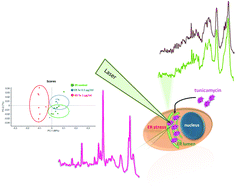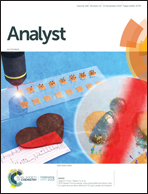Tunicamycin induced endoplasmic reticulum changes in endothelial cells investigated in vitro by confocal Raman imaging†
Abstract
This paper describes how tunicamycin (Tu), the most widely used pharmacological agent for inducing endoplasmic reticulum (ER) stress, interacts with endothelial cells. Our results show that tunicamycin enters the cells and accumulates within the ER area. ER stress takes place when improperly folded or damaged proteins begin to accumulate; however, spectroscopic markers of these changes have not been identified as yet. In this work, Raman spectroscopy and scanning electron microscopy imaging of individual endothelial cells treated with Tu were performed. The changes in the biochemical composition of endothelial cells induced by Tu attributed to ER stress were studied in detail. A main feature of the Tu impact on the cells was a decrease of the phospholipid content in the area of ER, and the most abundant lipid with phosphorus groups found there, was identified as sphingomyelin.



 Please wait while we load your content...
Please wait while we load your content...